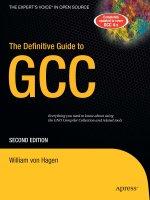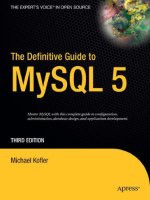Start writing a definitive guide to writing a high traffic blog
Bạn đang xem bản rút gọn của tài liệu. Xem và tải ngay bản đầy đủ của tài liệu tại đây (2.81 MB, 67 trang )
Contents
About This Book
3
Copyright
4
Preface
5
About The Authors
6
3 Things Every Blogger Needs To Know
7
Where We Write Determines What We Write
10
You Must Master These 4 Blogging Methods
14
How To Write Blog Posts Your Readers Actually ...
18
How To Identify And Overcome Writer’s Block
23
Fresh Blogging Ideas That Will Give Your Content ...
27
3 Ways You Can Accidentally Become A Content Marketing ...
31
Do You Have Enough Evergreen Content On Your Blog?
35
5 Ways To Make Your Blog Better Today
39
Create A Style Guide For Your Team Blog
44
There’s Only 1 Thing That Matters To Writing A ...
49
Outsell, Outsmart, And Outbid Your Blogging Competition ...
53
Out-Blog Your Competition By Developing A Spirit ...
58
How To Blog And Change The World
63
Turn Your Blog Into An Online Powerhouse
67
2
About This Book
Everyone is blogging. Or at least, everyone is talking about blogging. Unfortunately,
most blogs don't make it past three months.
Why?
Because starting a blog is easy, but it takes work to keep it going. In other words,
there's a right way to do it and a temporary way to do it.
We're going to tell you the right way to blog, so that your words last.
3
Copyright
From Todaymade.com
Copyright © 2013 Todaymade
We hope you enjoy this book. For questions or feedback contact us at our website
or email us:
4
Preface
Everyone is blogging. Or at least, everyone is talking about blogging. Unfortunately,
most blogs don't make it past three months.
Why?
Because it's easy to start a blog, but a lot of work to keep it going. In other words,
there's a right way to do it and a temporary way to do it.
We're going to tell you how to blog so your words last.
We're going to tell you how to get past writer's block when you run out of ideas.
We're going to tell you how to use your blog to build up your website.
We're going to give you tips and tricks for creating great headlines, and catching
the attention of readers using search engines.
Why?
Because the world doesn't need more blogs. It needs more great bloggers. And
that's you.
5
About The Authors
Garrett Moon is a founder at Todaymade, a web development and content
marketing company, and the makers of CoSchedule, an editorial calendar for
WordPress that makes content marketing and social media easy. He blogs for
several of the Todaymade blogs.
Julie R. Neidlinger is a copy writer and blogger at Todaymade, and has had her own
personal blog since 2002.
6
3 Things Every Blogger Needs To Know
Before you get started blogging, there are three things you must understand.
Three things that you can't ignore.
You Are Writing Publicly
You’re not just writing in your private journal, for your co-workers, or for a
controllable semi-private audience. You’re writing for the world.
This shouldn’t terrify you and keep you from writing.
7
It shouldn’t make your writing stiff and formal. It shouldn’t trap you in that black
hole of editing and proofing a draft over and over and never having the courage to
click publish.
But it probably will.
Your job, as a blogger, is to click publish, and keep improving from then on.
Performing in front of a huge audience is terrifying, so focus on the real people you
actually know and write as if you were writing for them.
Defeat the blank screen and write for the world with real people in mind. Make
your content interesting for them all. You are writing publicly.
You Are Responsible
Write responsibly. That doesn’t mean you have to water down your message. But,
because you’re writing for the world, you must be aware of the effect your writing
will have.
I’m not just talking on how your content affects people on a personal level, but also
how it affects you legally. This includes issues such as copyright and trademark
infringement, libel, deep linking, paid-for posts or content, privacy, content theft,
and even, though you might be blogging in another country, an understanding of
U.S. law. Your innocent blogging intentions have legal ramifications.
You can’t steal content, you can’t make up quotes, you can’t falsify information, you
can’t lie and say you didn’t, and you need to be able to back up your claims. It’s
easy to get a blog; there are free options everywhere. A low barrier to entry doesn’t
negate these responsibilities.
You are responsible for the content you create. Understand that.
You Must Be Honest
Usually when people talk about honesty in relation to a creative activity (which
writing and blogging is), they tend to point it back towards self. As in “you must be
honest with yourself.”
Fine.
Write honestly so you can live with yourself. Write honestly, but don’t let it be an
excuse to be a jerk. So yes, be honest with yourself.
But you must be honest with your audience above all.
8
Don’t let marketing trends ever come before being honest with your readers. Don’t
let what a social media marketing guru-ninja-expert-maven tells you to do ever
supercede your responsibility to be honest to your audience. Don’t hook, snare, or
deceive your reader in any fashion and use them merely as a means to an end.
What you write, how you engage, what you present, and what you promise – it
must be done honestly. You must have an audience that trusts you, or you have
nothing.
How do you build trust?
There is no app for building trust, no gimmick, no formula. Trust is built over time
by being honest.
If you say something will work, it had better work. If it doesn’t work for your reader,
you’re a liar to them. If you get paid to review or write a blog post, you had better
tell your reader up-front. You do all of these things not because you don’t want
trouble with the FCC or other bloggers, but because you care about your audience.
If your first inclination isn’t to be honest with your reader, but to make money off
of them or use them as a springboard for personal gain, do everyone a favor and
stop blogging.
9
Where We Write Determines What We
Write
In 1997, author David Shenk wrote the book Data Smog: Surviving The Information
Glut. He theorized that the explosive growth of information made possible by the
Internet was both helping society make forward-progress while simultaneously
overwhelming us, the individual. He later revisited his original ideas, and posited
that some still held true.
In one section of the book, Shenk noted that with the use of computers, our
geography of learning has become singular.
10
That is, we read, learn, write, communicate, buy, and sell all from the same
geographic place: in front of our computer. He was concerned about how well we
would retain information, since our memory and retention of information is often
tied to the place and situation in which it was learned. By limiting where and how
we learn (in front of a computer, reading/watching a screen), we have the potential
to lessen our ability to retain information.
The same can be said for the geography of writing. Where we write has an impact
on what we write in three key ways.
Multi-tasking Is An Idea Sieve
We mostly write on a computer. While it might not seem different than sitting at a
desk and writing on paper, or typing on a typewriter, there is a key difference: Our
computers are connected to the Internet.
While blissfully able to do research right where we sit as we write, we are also able
to “multi-task”, distracting ourselves with Facebook or email or the rabbit hole that
is the Internet as we click and lose ourselves in web pages.
Writers need to write.
We don’t need any encouragement to be distracted and not write. Multi-tasking is a
skeptical achievement at best, but for a writer, it can be deadly. It aids and abets
idea loss, and idea distraction.
Multi-tasking is not the same as brainstorming or research; that is something we
decide specifically to do.
When it comes time to write, our research and idea gathering should be done and
ready to serve the larger purpose of writing. We should be ready to go. Don’t let
our place of writing get in the way of writing.
Finding Our Niche, And Then Never Leaving It
Shenk believed that an information society wouldn’t necessarily bring about
broader information gathering or an expansion of ideas, but would make
nichification easier. That is, it would make the gathering of the kind of information
we were already drawn to that much simpler, overriding most people’s desire to
leap into something new.
Should a marketing blog be only about marketing?
11
Maybe. But, from a writer’s perspective (and probably a grateful reader, too), a
marketing blog that includes topics not commonly thought to be associated with
marketing has more value.
Branching out and extending our learning and writing of content from beyond our
tightly fenced niche means we avoid recessive inward-looking writing. Be aware
that self-limiting niche writing can quickly lead to dried-up ideas and writer’s block.
Getting Inspiration From A Place
Where we write influences what we write.
If we only write on a keyboard in an office while staring at a wall, our writing
actually reflects that in subtle ways. It might show up in the broad topics we
choose, or the words and descriptions we write. Our surroundings become like
background noise, rarely offering new inspiration. The outside doesn’t influence,
because we aren’t even aware of it.
How do you let what’s around you influence your writing? Does locality have any
effect on your writing?
Let’s say we write a blog for businesses, and we are about to write on customer
service. We could research examples online and rehash facts and other opinions.
But why not go to a local coffee shop during a busy time, get our notebook or
laptop out, and just observe what happens? Why not use actual observation of
customer service in action to come up with ideas for our blog post on customer
service?
Author Lawrence Durrell said writers can tap into the “spirit of place.” While we
can’t always get away from our desk or computer, keeping a notebook handy to jot
down observations or ideas when we’re out and about helps tap into that “spirit of
place” and we are able to bring it back to our writing later.
Escaping Data Smog And Getting A Breath Of Fresh Air
How do we successfully address data smog when it comes to our writing?
1. Consider where we write. We shouldn’t always write in the same place. While
we might not be able to drag our computer everywhere, we can use a tablet,
laptop, or notebook and pen in other physical locations and do some writing or
idea generating. New environment, new inspiration.
Consider writer’s block. Writer’s block has a distinct connection to the
12
Consider writer’s block. Writer’s block has a distinct connection to the
geography of place. A solution is to change the place we write. It works.
2. Consider your part. Write clearly and succinctly, keeping in mind that we don’t
want to contribute to data smog. Cut the fat. It makes for better writing, and hit
helps readers from being overwhelmed.
It isn’t just “creative” or fiction writers that should consider the importance of the
geography of writing.
Businesses and bloggers can benefit no matter what kind of content they are
intending to generate. All writing is creating, and our creative mind works in
amazing ways, picking up cues from everything. By limiting where we write, we
limit what we write.
13
You Must Master These 4 Blogging
Methods
There are four methods of approach for any topic or content piece, and
understanding how best to use these four methods can make or break your
blogging (and guest blogging) career. Readers will read your blogs based on your
ability to use these four methods, not on luck.
The General Post
A general post is written for introductory purposes.
14
It might be the start for an upcoming blog series with the intent being to lay the
groundwork for what will be explained in greater detail later. Or, it might introduce
new ideas or trends that the audience hasn’t heard about yet.
If not connected to a specific series or with the intention of continued blogging on
a subject in an informal series, general posts run the danger of being vague and
useless. Weak blog posts that seem to be little more than fluff and formula are
usually poorly written general blog posts. They might sound good, and even
contain true generalized ideas, but they rely on broad concepts and statements
without injecting them with value. They do not take use research, facts, or
examples to substantiate. They tell, but don’t show.
General posts are not necessarily bad, however.
They can be well-written, particularly in the context of the whole blog and if done
by a writer who envisions how this general post will fit into a larger, regular
blogging program. A blogger firmly ensconced in regular writing for a blog knows
both the content that has been published and the content that will be published,
on the editorial calendar. In this situation, a general post can be extremely useful.
Do write a general post in prepration for continued and future exploration. Don’t
write a general post and submit as a guest blog post on another blog.
The Specific Post
A specific post is exactly that: a post filled with specific detail.
It might be a how-to post, or a post with code snippets and screenshots. It might be
about marketing with links to helpful sites or a five-step list of what not to do in a
PR disaster. Nearly any topic can be broken down into a specific post.
A specific post dives deep into the subject matter. It does not focus on a broad
topic (e.g. “marketing”) but instead delves into something more narrow (“small
business tips for marketing with Tumblr”).
Just as teachers tell students to not choose too broad a topic for a final paper,
bloggers need to do the same for this kind of post. A detailed and meaty post that’s
headed past 1000 words might work as a series and eventual ebook.
15
A weak version of the specific post happens when the topic is narrow but the
blogger doesn’t have enough knowledge or content to fill it out, and instead veers
into generalities to cover for this. Specific posts do not use abstract phrases like
“they say” or “it has been shown” or other similar phrases as proof without backing
it up with a link, research, or screenshot.
You must show, not just tell.
If you say “users should choose a good design” and don’t provide readers the
details that would help them follow your advice, it isn’t helpful to the reader.
Do write a specific post to submit as a guest post or as part of a series. Don’t write
a specific post on a topic that’s new to you or your readers, or one you don’t know
much about yet.
The Philosophical Post
Philosophical posts are “idea” posts.
Their main goal is to further the culture of the brand or team writing the blog.
These posts are as much for the writer as the reader, helping to clarify the thought
process and leading on to other posts that come to mind as the writer is working
through the initial idea.
Philosophical posts are good in that they reveal the writers as real people. They
don’t generally come from a place of hierarchy (i.e. teacher-down-to-student), but
are instead on the same level. The reader is walking beside the writer and working
through the idea.
These posts are great discussion starters. They get everyone thinking and talking.
They often stem from books or other outside influences that have caused the
author to think about new things and apply them to a current situation.
Do write philosophical posts for your own blog. Don’t write philosophical posts for
a blog or brand you’re not extremely familiar with.
The Action Post
An action post could be any of the above three, but with one difference: it always
includes something actionable for the reader can do.
16
It should leave the reader feeling that yes, they can do something about the
problem described. These work well if you’ve written your post with the plot
triangle in mind, presenting a problem, the proof, and a conclusion that gives the
reader a chance to be part of the solution.
What do we mean by “action”?
It might lead your reader to sign up for your email newsletter, get an ebook
download, or maybe even three life changes they can make today. It is anything
that takes them beyond passive reading into action.
Do use the action post as a guest blog post, on your own blog and in guest posts.
Don’t overuse the same action element (“get our email!”) because you’ll train
regular readers to ignore it after a while.
17
How To Write Blog Posts Your Readers
Actually Want To Read
Did your blog post put several readers to sleep today?
Too bad. Any topic has the opportunity to instill excitement. Using a centuries old
writing technique, you can not only keep your reader awake, but you can keep
them addicted to your blog.
The Fiction Pyramid And You
Off the record, we’re going to call it plain old curiosity.
18
Officially, though, it’s called the Freytag Pyramid. Or, as you might have learned in
school, the fiction pyramid or the dramatic arc. These are all fancy phrases for
telling us about what makes a good story. Take note: People love stories. They are
a curious bunch, and stories feed curiosity.
The pyramid looks something like this:
Introduction (and inciting incident):
This is the headline, the setup, the introduction of characters and setting.
For a blog post, you’re introducing the topic and necessary background
information to your reader. You’re laying out your case. At the end of the
introduction, the conflict (inciting incident) is revealed. The reader is made aware
of a problem, which should make them curious about it if you’ve made them care
or be concerned enough in your introduction.
Rising Action:
This is where you build your case. The reader has the background info, and knows
of the problem. Here is where you begin fleshing that out and building in detail.
19
Use a few facts, charts, quotes, links — but whatever you use, be sure that it
doesn’t numb and disinterest the reader. You want to keep them reading.
Climax:
This is the pinnacle of your argument, your idea, your theory.
Or, in the case of a simple how-to post, the nudge to reassure them that your steps
should be followed. It tells the reader that yes, they should be doing this because
the alternative is to make a common mistake others have made who haven’t used
your step-by-step expertise.
However you handle it, this is the point where you convince them that the case you
laid out for them was true, and that it applied to them. The problem you stated
was their problem, too.
Falling Action:
Now that you have your reader’s attention or concern (and hopefully trust, since
they’re still with you this far), you close out your argument and start to suggest to
them that there’s a way to solve the problem, and you’ll share it with them.
Resolution (and call to action):
Here is where you present your solution, your conclusion, and your final thoughts.
If you want your reader to do something specific, this is a good time to ask them. A
well-written blog post that has presented a problem or concept that convinced
readers it applied to them will leave them wanting to take action immediately so
they can feel that they’ve taken part and concluded the issue for themselves.
Here is where you can get email addresses, sell your ebook, or offer your
download. Give them something to do, and be clear you’d like them to do it
because it’s part of the solution.
This pyramid works.
It has hooked readers for centuries. It works even when you switch a few elements
around (start with a bold climactic statement, for example, and then follow with
the introduction).
20
It works because that’s what readers want. They want to be eased into what’s going
to happen, they want to have a reason to keep reading, they want to feel tension
because it creates a feeling of possibility and curiosity and excitement, and then
they want it brought back down with the problem resolved and a sense of things
being finished and their curiosity sated. It works.
Your blog posts should make use of this pyramid.
What Does That Pyramid Have To Do With My Blog?
Just because you’re not writing a novel doesn’t mean this technique isn’t for you. As
brief as possible, the work of your blog post writing is as follows:
1. Headline gets initial reader attention.
2. Reader then reads the first line.
3. The first line causes the reader to want to read the second line.
4. This continues.
5. At any point where the writing dwindles and a line doesn’t lead on to a line, the
reader leaves. They lost curiosity.
6. If each line leads to the next, the reader keeps with you to the end.
The beauty of the fiction pyramid, if done well, is that it leads the reader willingly to
the end.
They are willing to do the work of climbing to the key point you want to make and
then stay with you to the end. They are willing to give you an email, or buy the
book.
You convinced them through the story, and they’ll take part in more. They gave you
permission to do so.
Make Twitter As Exciting As A Mystery Novel
Let’s try an example, and use that post you’re going to write, the one on setting up
a Twitter account. You could say:
“Getting a Twitter account is a good idea. The first thing you want to do is sign up.
Choose a username and password, and login. Then, you’ll want to upload an
icon…”
That’s useful. It’s true. You’ll get readers who might hop in, read it, and bounce
right back out after getting the information they needed.
21
However, wouldn’t you rather pique their interest enough that they might
subscribe to your email or RSS feed? Each post you write has velcro potential. What
if you wrote it like this instead:
“The first thing you’ll need if you want to use Twitter is to learn to say less. No,
really. Twitter gives you 140 characters and that’s it. Confident you can pull it off?
Then these next five steps will make you a Twitter maestro.”
One has sequential facts. The other feeds curiosity, revealing information in a drip
feed.
No Way Am I Using A 5-Part Structure For A Blog Post
Let’s say the five parts aren’t appealing to you. It sounds complicated. Break the
pyramid down, and what do you have?
1. Here’s my idea.
2. Here’s my data.
3. Here are solutions.
The key is building curiosity to keep the reader interested, making them willing to
hear your call-to-action and giving you permission to ask them to do something.
The pyramid helps do that.
If you don’t want to use a 5-part formula, that’s fine. Just remember that each line
must lead to the other, and that people expect to be introduced, convinced, and
given something to do.
The beauty of it is that after a period of consistently addictive blog posts, your blog
itself becomes addictive.
People are curious to know what you’ll be saying today. If your readers are coming
to read, but dropping off like flies before the end, reconsider your story technique.
It’s not hip to be square. Be a pyramid instead.
22
How To Identify And Overcome
Writer’s Block
It’s a lovely ideal, that image we have of inspired writers busy writing, barely able to
keep up with the words that flow from their pen, but it’s not very realistic.
Writers get writer’s block, whether they’re writing the company blog or the next
Great American Novel. While it is mainly an issue of perseverance, it helps to
understand why it happens and to have a few tools to break through the creative
wall.
Why Writer’s Block Happens
Writer’s block seems to happen when we least expect it, but there are a few
predictable causes.
23
1. Give the rough draft a fair chance to exist.
We want things perfect from the beginning, and so we self-edit as we write,
choking the words before they can get on the page.
Write freely and know you can edit later. When it’s time to write, write. Editing and
refinement will follow.
2. Sometimes we write for other’s eyes.
While our end goal is to have readers reading our work, the initial process doesn’t
involve anyone but ourselves, our own eyes, and our own ideas.
Writing for someone else is very similar to being uncomfortable with rough drafts:
we are embarrassed by our clumsy initial attempts and constantly go back to clean
things up when we should just be writing forward. It’s important to have an
audience in mind for our writing, but we need to understand that the audience
reads the final product, not the crazy notes and horrible paragraphs we start out
writing.
3. Writing is work, and that’s a little surprising.
The fact that it sometimes feels like work, that the words aren’t readily available on
any given day, doesn’t mean we have writer’s block. It just means sometimes the
words come easy and sometimes they don’t, but they do come.
Writing through writer’s block is the best way to show it who is boss, whether we
do that writing on the project that is giving us grief, or on something else. Writer’s
block is best thought of as project-specific, and not person-specific. If we’re stuck,
that’s a statement about the writing at hand, and not us as writers.
Writing doesn’t just happen. It’s something we practice regularly, and can do on a
schedule.
Don’t get it right, just get it written.
– James Thurber
Identify The Block
We need to know what kind of writer’s block we’re dealing with to find the best
solution.
Is it the lack of an idea that is preventing us from even getting started? Maybe we
have an idea, but we don’t know what to do with it, or how to get started. Or
perhaps we’ve been writing and thought we were working through an idea without
any issue until we hit the middle and found ourselves stuck.
24
Determine what it is that is keeping us from moving forward so we know what
solution to look for.
I only write when I am inspired. Fortunately I am inspired at 9 o’clock every
morning.
– William Faulkner
Solve The Specific Block
Once we’ve identified what kind of block we’re struggling with, we can find a
solution.
If the problem was finding an idea, we need to figure out how to generate ideas. A
visual person, for example, might be inspired by doing random image searches
online and using those images to create a backstory or concept.
Other inspiration can be found through RSS readers, Facebook News Feeds,
Google+ Saved Searches, books we're reading — these are all places to find
content that serves as an idea springboard for our own. We aren’t looking to these
to copy, but to jog our already capable writer’s mind into gear.
If the problem was that we had an idea but didn’t know how to get started, or we
were stuck in the middle of an idea, we need our own personal system for
breaking things down.
Whether it’s brainstorming, writing random related thoughts down on cards and
mixing them up, word association, writing a stream of consciousness, or using flow
charts, we just need to find what works.
The easiest thing to do on earth is not write.
– William Goldman
Methods To Overcome
There are countless numbers of ways that writers overcome their writer’s block. No
one finds the same success with each method. Anything that jars us into new paths
of thought will work. Here are a few ideas to try:
Change your geography. If you were writing at the kitchen table, move to the
desk, or the front porch. Go to a coffee shop, or the library. Change the location
of where you’re writing. Different sounds and distractions can jog the creative
mind.
Get creative. Clear your head by doing some creative writing exercises. Word
associations, writing prompts, idea generation — anything to get your writing
skills out of the temporary rut they are in.
Stop, and write something else. As a last ditch effort, stop what you’re writing
25









